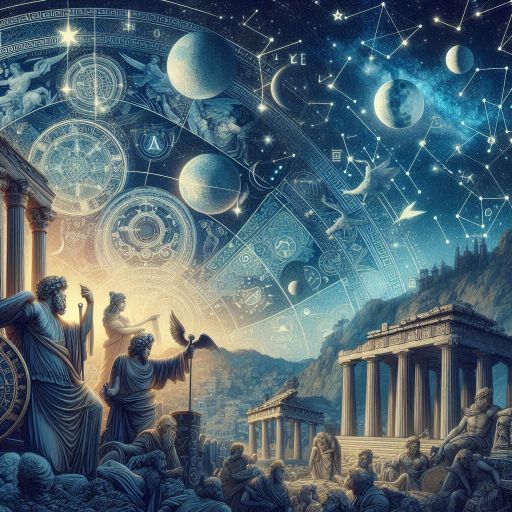From the dawn of civilization, humans have gazed at the night sky in wonder, seeking meaning in the stars, planets, and other celestial bodies. Ancient cultures around the world crafted intricate mythologies to explain the movements and mysteries of the cosmos, and the Greeks were no exception. Greek mythology is rich with tales that connect the gods and heroes to the heavens, giving us a glimpse into how the ancients viewed their place in the universe. In this blog post, we'll explore the fascinating links between celestial bodies and Greek mythology, revealing how these stories have influenced our understanding of the cosmos, along with the remarkable contributions of ancient Greek astronomy to science.
Table of Contents
- The Sun: Helios and Apollo
- The Moon: Selene and Artemis
- The Planets: Gods and Their Domains
- Constellations: Heroes and Monsters in the Sky
- The Milky Way: Hera’s Divine Milk
- Astronomy in Ancient Greece
- Conclusion
- Interesting Facts: Greek Mythology in Modern Astronomy
The Sun: Helios and Apollo

In Greek mythology, the Sun was personified by two deities: Helios and Apollo. Helios was the original sun god, depicted as driving a chariot across the sky each day, bringing light to the world. His journey from east to west symbolized the daily rising and setting of the Sun. Over time, Apollo, the god of music, prophecy, and healing, became associated with the Sun as well. By the Classical period, Apollo was often depicted as the Sun god, embodying the qualities of light, knowledge, and truth.
The Moon: Selene and Artemis

The Moon, like the Sun, had its own divine representation in Greek mythology. Selene, the goddess of the Moon, was often depicted as a beautiful woman with a crescent moon on her forehead, driving a chariot across the night sky. Selene was later associated with Artemis, the virgin goddess of the hunt, who became the protector of the night and was also linked to the lunar cycle. Artemis was known for her connection to wild nature and the cycles of life, mirroring the waxing and waning of the Moon.
The Planets: Gods and Their Domains
The planets visible to the naked eye were named after Greek gods, each representing different aspects of life and the universe.
Mercury: Hermes

Mercury, the fastest-moving planet, was named after Hermes, the messenger god known for his speed and cunning. Hermes was also the god of travelers, commerce, and communication, reflecting the swift and elusive nature of the planet.
Venus: Aphrodite

Venus, the brightest planet in the sky, was associated with Aphrodite, the goddess of love and beauty. The planet's dazzling appearance symbolized the allure and charm of Aphrodite, who played a central role in many myths related to love and desire.
Mars: Ares

Mars, the red planet, was linked to Ares, the god of war. The planet's reddish hue reminded the ancients of blood and conflict, fitting for the bellicose nature of Ares, who was both feared and revered as the embodiment of war and aggression.
Jupiter: Zeus

Jupiter, the largest planet in the solar system, was named after Zeus, the king of the gods. Zeus ruled the heavens with his thunderbolt, just as Jupiter dominates the night sky with its size and brightness. Zeus was associated with law, order, and power, reflecting the planet's massive presence.
Saturn: Cronus

Saturn, known for its slow orbit, was named after Cronus, the titan god of time. Cronus, the father of Zeus, was often depicted as an old man with a sickle, symbolizing the passage of time and the inevitability of change. Saturn's slow journey through the sky mirrors Cronus's association with the relentless march of time.
Constellations: Heroes and Monsters in the Sky
Greek mythology is rich with stories of heroes, gods, and monsters, many of which are immortalized in the stars as constellations.
Orion
Orion, the great hunter, was placed among the stars by Zeus after his death. The constellation Orion is one of the most recognizable in the night sky, and its position in the sky changes with the seasons, reflecting the hunter's eternal pursuit of his prey.
Andromeda and Perseus
The story of Andromeda and Perseus is also written in the stars. Andromeda, chained to a rock as a sacrifice to a sea monster, was saved by Perseus, who used the head of Medusa to turn the monster to stone. The constellations of Andromeda, Perseus, and Cetus (the sea monster) tell this heroic tale every night.
The Pleiades
The Pleiades, a cluster of stars in the constellation Taurus, were the seven daughters of Atlas and Pleione. These stars were pursued by Orion, and to save them, Zeus transformed them into a group of stars. The Pleiades are often associated with themes of pursuit and protection, representing the bond between the sisters and their celestial guardian.
The Milky Way: Hera’s Divine Milk

The Milky Way, the galaxy that contains our solar system, was explained by the Greeks as a result of Hera’s divine milk. According to the myth, the Milky Way was formed when the goddess Hera, Zeus’s wife, spilled her breast milk across the sky. This celestial river of milk became the brilliant band of light we see stretching across the heavens.
Astronomy in Ancient Greece

Geocentrism and the Earth-Centered Universe
In ancient Greece, the dominant cosmological model was geocentrism, the belief that the Earth was the center of the universe. This idea was championed by philosophers like Aristotle, who proposed that the Earth was stationary and that all celestial bodies revolved around it in perfect circles. The geocentric model was further refined by Claudius Ptolemy in his work "Almagest," where he introduced the concept of epicycles to explain the apparent retrograde motion of the planets.
Eratosthenes and the Measurement of the Earth
One of the most remarkable achievements of ancient Greek astronomy was the measurement of the Earth’s circumference by Eratosthenes around 240 BCE. Using the angles of shadows cast at noon in two different locations (Syene and Alexandria) and the distance between them, Eratosthenes was able to calculate the Earth's circumference with remarkable accuracy. His work demonstrated that the Earth was not only spherical but also that it could be measured scientifically.
Hipparchus and the Star Catalog
Hipparchus, often considered the greatest ancient Greek astronomer, made significant contributions to the field of astronomy. He compiled the first comprehensive star catalog, which included the positions and magnitudes of over 850 stars. Hipparchus also discovered the precession of the equinoxes, a slow shift in the orientation of the Earth's axis that affects the position of the stars over time. His work laid the foundation for future astronomical studies and remained influential for centuries.
Ptolemy and the Almagest
Claudius Ptolemy, though technically from the Roman period, was heavily influenced by Greek astronomy. His work "Almagest" synthesized and expanded upon the ideas of earlier Greek astronomers. In this seminal work, Ptolemy developed a detailed geocentric model of the universe, with planets moving in complex combinations of circles (deferents and epicycles) to account for their observed motions. The "Almagest" became the authoritative astronomical text for over a thousand years, shaping medieval and Renaissance astronomy.
Thales of Miletus
Thales of Miletus, one of the pre-Socratic philosophers, is often credited as the first Greek astronomer. He proposed that the Earth was a flat disk floating on water and was among the first to attempt to explain celestial phenomena without invoking mythology. Thales is also reputed to have predicted a solar eclipse in 585 BCE, marking an early example of scientific prediction.
Anaxagoras
Anaxagoras was a pre-Socratic philosopher who made significant contributions to astronomy. He proposed that the Sun was not a deity but a fiery mass, and that the Moon reflected the Sun's light. Anaxagoras also explained solar and lunar eclipses as natural phenomena, challenging traditional mythological explanations and laying the groundwork for a more scientific approach to understanding the cosmos.
Aristarchus of Samos
Aristarchus of Samos was a pioneering Greek astronomer who proposed a heliocentric model of the solar system, suggesting that the Earth and other planets revolved around the Sun. Although his ideas were not widely accepted at the time, Aristarchus's work was a precursor to the heliocentric theories that would later be developed by Copernicus and Galileo.
Conclusion
The Greeks' deep connection between the heavens and their mythology reflects a culture that sought to understand the cosmos not just through observation but also through stories that gave meaning to the stars. Their contributions to astronomy were pioneering, laying the groundwork for future scientific advancements. From the geocentric model to the measurement of the Earth, ancient Greek astronomers pushed the boundaries of knowledge, blending mythology with scientific inquiry in a way that continues to inspire us today.
Interesting Facts: Greek Mythology in Modern Astronomy
Many celestial bodies discovered in modern times are named after Greek mythological figures. For example, the planet Pluto, though now classified as a dwarf planet, is named after the Greek god of the underworld. The moons of Jupiter are named after Zeus’s lovers, including Europa, Io, Ganymede, and Callisto. Even the modern constellations continue to carry names rooted in Greek mythology, ensuring that the stories of the ancients remain written in the stars.
Interested in Greek mythology? Click here

